FSA Partnership Meetings:
March 1: Suncoast Partnership, 1-3pm, Eckerd College, RSVP to forysea@eckerd.edu or HSort@Audubon.org
March 5: Space Coast Partnership, 1pm-4pm, Kiwanis Island Park, RSVP to Jean.Olbert@MyFWC.com
March 6: Southeast FL Partnership, 10am, Manatee Lagoon, RSVP to Natasha.Warraich@MyFWC.com
March 8: Volusia County Partnership, 9am-1pm, Lifeguard HQ, Conference Room A, RSVP to jwinters@volusia.org
March 9: Treasure Coast Partnership, 9am-12pm, Ecoheritage House at Richard E Becker Preserve, RSVP to Dan.OMalley@MyFWC.com
March 12: Timucuan Partnership, 10am-1pm, Ribault Club, RSVP to Blair.Hayman@MyFWC.com
March 13: Keys Partnership Meeting, time 10am, Marathon Public Library, RSVP to keywestwildlifecenter@hotmail.com
March 15: St. Johns/Flagler Shorebird Partnership, 1pm-4pm, Guana Tolomato Matanzas National Estuarine Research Reserve. RSVP to Jean.Olbert@MyFWC.com
March 16: Lee County Partnership, 1-3pm, Lakes Regional Library, RSVP to Morgan.Parks@MyFWC.com
March 20: Nature Coast Partnership, 9am-12pm, FWC Marine Laboratory in Cedar Key, RSVP to Megan.Wallrichs@MyFWC.com
Monitoring Training & March Count Window:
March 7: Webinar for new surveyors, 1-2pm Eastern. Learn the basics of the Breeding Bird Protocol and how to enter surveys in the database.
March 8: Webinar for returning surveyors, 1-2pm Eastern. This refresher includes 2018 updates to the database and protocol review.
March 9: Webinar for rooftop monitors, 1-2pm Eastern. Learn the basics of monitoring seabirds and shorebirds on rooftops.
March 18-24: 1st count window of the Breeding Bird Protocol
Events:
March 1st: Data entry deadline for the Winter Shorebird Survey
March 8: Mantanzas Inlet Shorebird Walk
March 16-17: Southwest Florida Birding Seminar
March 21: Lecture - Sea Turtles and Shorebirds and Snowbirds, Oh My!
The 2018 nesting season is upon us!
This month's newsletter is all about helping you prepare for shorebird conservation and monitoring. Your local partnership is organizing many activities, so please coordinate with them. The best way to do that is to attend a partnership meeting. If you can’t attend the meeting but would like to get involved, please contact shorebird@myfwc.com. Here are a few ways to get started:
Be a mentor, or team up with one. Does your partnership have new members? If so, encourage them to join a local bird steward program or bring them along on a monitoring survey. If you're a new member, check with your partnership for training and mentoring opportunities.
Get posting supplies. Do you have the posting supplies you need to cover your areas? Let your FWC regional shorebird contact know if you need signs (see our sign selection)
Get outreach materials. There are posters, brochures, coloring books, rooftop signs for businesses, etc. (see selection). Your FWC regional office may have them in stock.
Prepare for route surveys. If you have an assigned route, will you be able to survey it during all 6 count windows? If not, please find someone to fill in for you (or contact us for help). Remember to coordinate survey plans with your local partnership and register for a route or rooftop training webinar.
Prepare for roof checks. Review our list of historic rooftops. Can you help monitor any of these? Coordinate with your partnership or contact us. Please let us know if roofs are no longer suitable for nesting (building was torn down or re-roofed).
Read on for more details about getting involved this season...
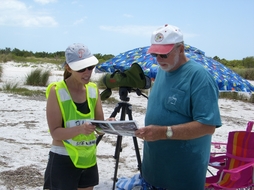 Bird Stewarding and Outreach
Summer weekends and holidays can be disastrous for nesting shorebirds and seabirds since the level of disturbance from people, pets, and vehicles is often higher than usual. In these situations, signs posted around the nests may not be enough to fully protect the sites. This is where bird stewards come in.
Bird stewards carry out two important tasks while out on the beaches: they minimize disturbance at posted nesting sites, and educate others about beach-nesting birds. We never know exactly where and when bird stewards will be needed until the birds have started nesting. After the nests and colonies are located, bird stewards begin their watches.
To volunteer as a bird steward this season, please check this map to see if there is a steward program near you. If so, please call or email the program contact to get involved. If there is not a bird steward program near you please contact us about starting one. In addition to stewards, land managers and private citizens can also do a lot to educate others about beach-nesting birds. We have outreach materials to help you get the message out to beach drivers, photographers, and pedestrians on the beach.
|
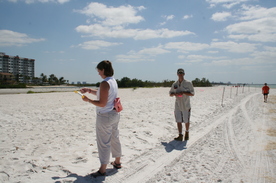 Posting Nest Sites
“Posting” means to install a symbolic fence of signs and twine or rope around a nest or colony. Posting is often the best tool to protect beach-nesting birds from human disturbance on popular beaches and islands. “Pre-posting” a section of the beach to give the birds an undisturbed place to initiate nesting is also a great tool, especially if you want to attract birds to a protected spot before they establish nests.
If you find a shorebird nest or seabird colony that has not yet been posted, please notify the local land manager or your FWC regional shorebird contact immediately so that it can be posted. Parks usually have their own preferred signs and posting materials, but if not (or if the nest is on private property), supplies and assistance can be requested by contacting your FWC regional shorebird biologist. Check out our sign selection – many can be printed off and laminated (remember to obtain landowner’s permission to post on private property).
Detailed posting instructions are available on the FSA website.
|
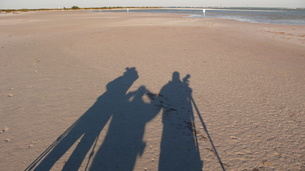 Breeding Bird Surveys and Training
Florida’s official shorebird monitoring
program begins this month, with the first count window from March 18th – 24th.
Everything you need to know to participate in the monitoring program can
be found on the Florida Shorebird Database (FSD).
The website’s INSTRUCTIONS tab details what the
monitoring program involves. The RESOURCES page contains videos on data
entry and the Breeding Bird Protocol, which explains the monitoring process and
includes data sheets.
All volunteers are encouraged to register for a
training webinar. The March 7th webinar is for new
volunteers who plan to survey a specific route (usually along the beach). The March 8th webinar is for returning volunteers and is
a brief refresher on how to survey routes. The March 9th webinar
is for volunteers who plan to monitor rooftops.
Register online by March
6th. All webinars are from 1-2pm Eastern.
Webinar details will be emailed to registered
participants on March 6th.
|
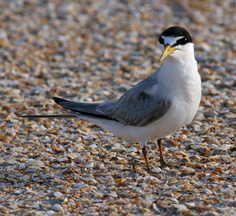 Rooftop Monitoring and Outreach
Many seabirds and shorebirds nest on gravel
rooftops in Florida, making rooftop monitoring and outreach important
components of our work. There are hundreds of rooftops throughout the
state where seabirds have historically nested, and we need your help monitoring
them. If you are willing to check on a nearby rooftop, there are many
resources to support you.
To get started, please see our list of historic rooftops. If the rooftop is
still suitable for nesting (the roof is still gravel), it should be checked at
least once during each count window this season. Complete rooftop
monitoring instructions and data sheets can be found on pages 12-14 of
the Breeding Bird Protocol.
If a historic rooftop is no longer suitable
for nesting (the building was torn down or re-roofed), please let us know
at FLShorebirdDatabase@myfwc.com.
If you see shorebirds or seabirds flying to or
from a rooftop, the birds are likely nesting on that roof. It is important to
talk to the property owners or managers, to help make them aware of the
protected species nesting on their roof. The building’s residents or
employees can alert you if there are falling chicks or other issues, so it’s
important to talk to them early in the season and leave a phone number they can
call. We have signs, letters, postcards, and other Rooftop Resources to help you with
outreach.
At rooftops where birds nest every year, there
may be things you can do to prepare for the upcoming season. First,
please remind the property owner to schedule rooftop repairs or air
conditioning maintenance the month before the birds arrive. Also, some partnerships
are “chick-proofing” rooftops, so please contact your local partnership to see if they need
help.
If you see chicks falling off the roof,
they should be returned to the rooftop as soon as possible. Please
consult the Chick-Checking Manual for further
instructions.
|

Spring Cleaning Checklist
Before entering your breeding data this season, you may want to do a little spring cleaning of your Florida Shorebird Database (FSD) account:
Remember, the Florida Shorebird Database website is most compatible with Google Chrome web browser. You can work faster and more efficiently using Chrome instead of other browsers.
Create a Florida Shorebird Database account if you don't have one yet and plan to monitor shorebirds and seabirds this season. (click on New User? Get registered).
If you already have an account, make sure that you can still log in. If your password doesn’t work, you can reset it by emailing FLShorebirdDatabase@myfwc.com. Please do not create a new account.
Check your Account Info (top right of screen). Is your contact information up to date? Do you have the correct Partnership selected? Select the partnership nearest you (preferred) or you can select “Multiple” if you belong to more than one partnership. Please update this section then click Submit.
Review the routes and/or rooftops on your MY DATA page (imported into your profile from last year). Are you still planning to survey those routes or rooftops this year? If not, you may want to remove them from your profile to speed up page loading (go to View/Edit and then select “Remove from My Data”). This won’t erase them from the system, but they will no longer appear in your profile.
Notify FLShorebirdDatabase@myfwc.com if a route or rooftop should be deleted from the database (e.g. there’s a better route for the area, or the rooftop is no longer gravel).
The database will be open for new data entry soon. If you have an FSD account, you will be notified by email as soon as it opens. You will be able to add new routes, rooftops, and nest sites to your profile when the database opens.
Thank you for your dedication to shorebird and seabird conservation. May the 2018 nesting season be highly productive!
Oklahoma-banded Snowy Plover Winters at Cedar Key
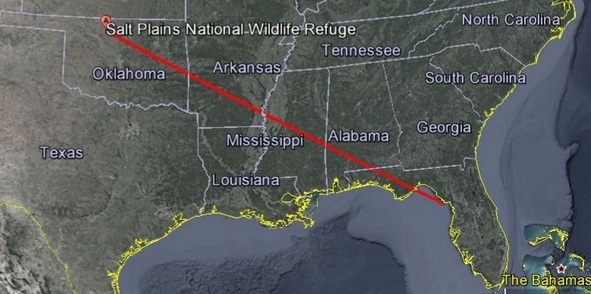
|